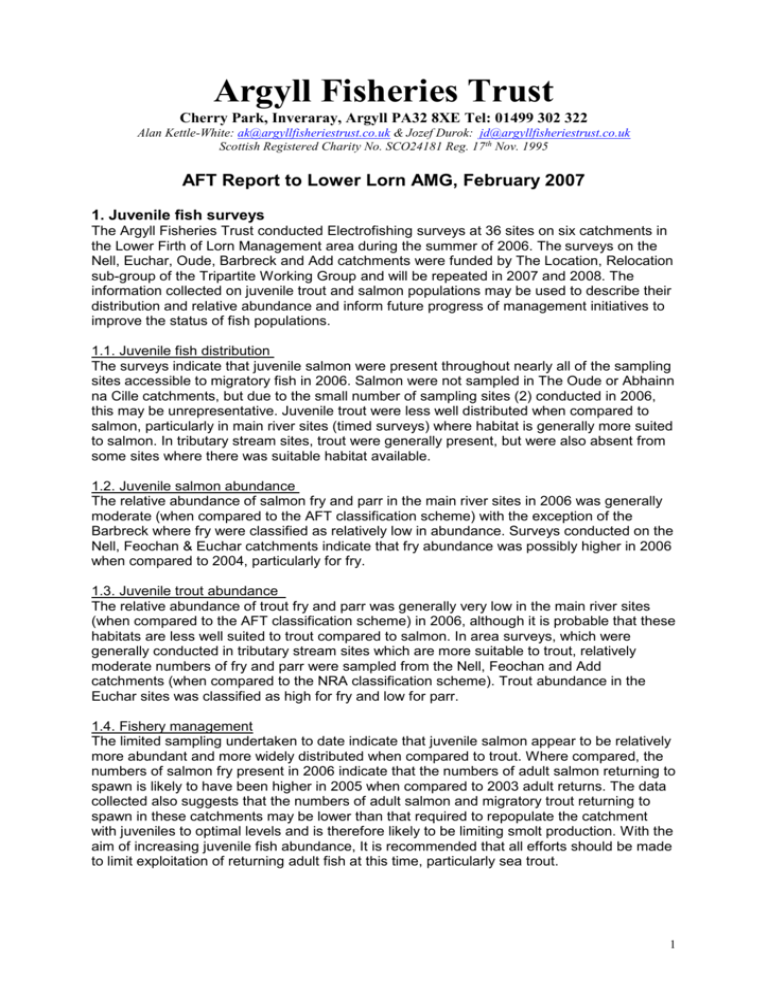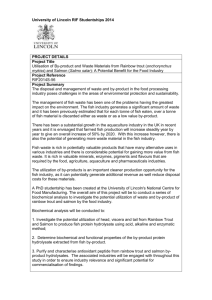Open
advertisement

Argyll Fisheries Trust Cherry Park, Inveraray, Argyll PA32 8XE Tel: 01499 302 322 Alan Kettle-White: ak@argyllfisheriestrust.co.uk & Jozef Durok: jd@argyllfisheriestrust.co.uk Scottish Registered Charity No. SCO24181 Reg. 17th Nov. 1995 AFT Report to Lower Lorn AMG, February 2007 1. Juvenile fish surveys The Argyll Fisheries Trust conducted Electrofishing surveys at 36 sites on six catchments in the Lower Firth of Lorn Management area during the summer of 2006. The surveys on the Nell, Euchar, Oude, Barbreck and Add catchments were funded by The Location, Relocation sub-group of the Tripartite Working Group and will be repeated in 2007 and 2008. The information collected on juvenile trout and salmon populations may be used to describe their distribution and relative abundance and inform future progress of management initiatives to improve the status of fish populations. 1.1. Juvenile fish distribution The surveys indicate that juvenile salmon were present throughout nearly all of the sampling sites accessible to migratory fish in 2006. Salmon were not sampled in The Oude or Abhainn na Cille catchments, but due to the small number of sampling sites (2) conducted in 2006, this may be unrepresentative. Juvenile trout were less well distributed when compared to salmon, particularly in main river sites (timed surveys) where habitat is generally more suited to salmon. In tributary stream sites, trout were generally present, but were also absent from some sites where there was suitable habitat available. 1.2. Juvenile salmon abundance The relative abundance of salmon fry and parr in the main river sites in 2006 was generally moderate (when compared to the AFT classification scheme) with the exception of the Barbreck where fry were classified as relatively low in abundance. Surveys conducted on the Nell, Feochan & Euchar catchments indicate that fry abundance was possibly higher in 2006 when compared to 2004, particularly for fry. 1.3. Juvenile trout abundance The relative abundance of trout fry and parr was generally very low in the main river sites (when compared to the AFT classification scheme) in 2006, although it is probable that these habitats are less well suited to trout compared to salmon. In area surveys, which were generally conducted in tributary stream sites which are more suitable to trout, relatively moderate numbers of fry and parr were sampled from the Nell, Feochan and Add catchments (when compared to the NRA classification scheme). Trout abundance in the Euchar sites was classified as high for fry and low for parr. 1.4. Fishery management The limited sampling undertaken to date indicate that juvenile salmon appear to be relatively more abundant and more widely distributed when compared to trout. Where compared, the numbers of salmon fry present in 2006 indicate that the numbers of adult salmon returning to spawn is likely to have been higher in 2005 when compared to 2003 adult returns. The data collected also suggests that the numbers of adult salmon and migratory trout returning to spawn in these catchments may be lower than that required to repopulate the catchment with juveniles to optimal levels and is therefore likely to be limiting smolt production. With the aim of increasing juvenile fish abundance, It is recommended that all efforts should be made to limit exploitation of returning adult fish at this time, particularly sea trout. 1 1.5. Further monitoring and investigation Further sampling of juvenile fish in 2007 and 2008 as part of the Area Management monitoring will better inform on the status of stocks and potential smolt production. It is also essential to continue to monitor the marine environments to identify trends in wild fish health and abundance over time as the AMA initiative develops. Continued investigations of the sea lice burdens of post-smolt sea trout in Loch Feochan and the development of new sampling sites in Loch Craignish / Crinan (as part of the AMA process) is necessary to monitor the health of sea trout in Lower firth of Lorn management area. Reports on the juvenile fish surveys have been drafted for individual catchments and distributed to interested parties. A summary report for the Lower Lorn area is also available. Further copies are available from the Trust office. 2. Genetic research The Atlantic Salmon Trust has financed the analysis of genetic samples taken from juvenile fish in the Nell and Euchar catchments and the net fishings at Dunach. The aim of the study was to establish the potential for within and between river structuring in west coast salmon populations. Initial results of this groundbreaking research are summarised as; 1. The molecular analysis carried out using 14 microsatellite markers to genetically type fish has been able to be informative with respect to the two objectives set out. 2. The analysis resolved significant population structuring between and within Feochan rivers, with a highly localized natal homing and spawning by returning adults, which has allowed genetic differentiation to evolve in the system; the populations from above the lochs on the Euchar and Nell are the most differentiated. Thus if stocking is carried out, it cannot be assumed that, even if fish come from the same river, that they are from the same breeding population as found in the location stocked; this will need to be assured for broodstock used as, if they are not, the resultant mixing is likely to destabilise adapted local gene complexes with unpredictable results. 3. The observed population structuring is sufficient to make it possible to determine both the proportion of the fishery originating from each river and to each identified population. 4. Adults sampled from the Dunach fishery in 2005 and 2006 originate from all three Loch Feochan rivers, with Euchar fish predominating and are indicated to make up in the order of 50% of the fish caught. The levels of confidence for the assignments are reasonable but not as high as in some other fishery studies, reflecting the relatively small levels of genetic differentiation which can be expected when contributing breeding populations are separated by small geographic distances. However, even with conservative assignment critieria, adults could be unambiguously assigned to all three rivers and, among these fish, the Euchar fish still constituted in the order of 50%. 5. All three Feochan rivers contribute to the fishery but it is possible that the proportions which come from each change throughout the season. This would be possible to test by sampling adults over the complete season at regularly spaced intervals. Biological data collected with the adults could provide information about the characteristics of particular populations e.g. the prevalence of early-running adults in certain parts of the system. It proved possible to use genetic data to estimate the effective numbers of breeders in the Feochan system salmon populations; upstream populations above Loch Scammerdale and Loch Nell appeared to have much lower numbers of breeders and this suggests these to be the populations most vulnerable to factors which may adversely effect them, such as exploitation, stocking of non-natives and habitat modification. Based on 2005 assignment 2 proportions, a fishery catch of 100 adults is estimated represent 14 to 21%, 21 to 25%, and 28 to 33% of Feochan Bheag, Lonan/Nell, and Euchar spawners. 3. Post-smolt sea trout sampling The AFT will be undertaking sampling of post-smolt sea trout in Loch Feochan in the spring and early summer of 2007 (May & June). It is also intended to establish monitoring sites in Loch Craignish / Loch Crinan to provide information on the southern part of the management area. Netting dates will be circulated as soon as possible. All helpers welcome. A. Kettle-White AFT Biologist 3







